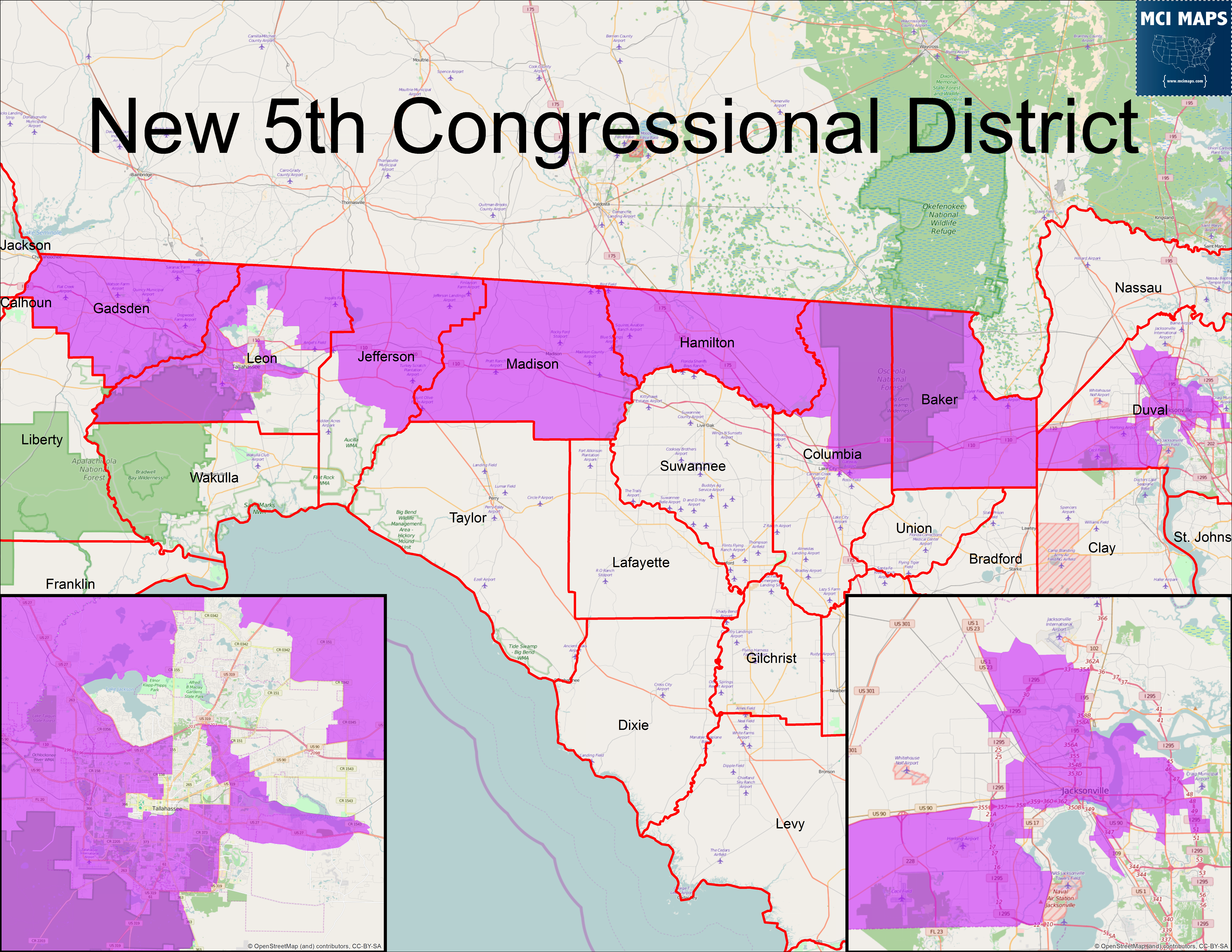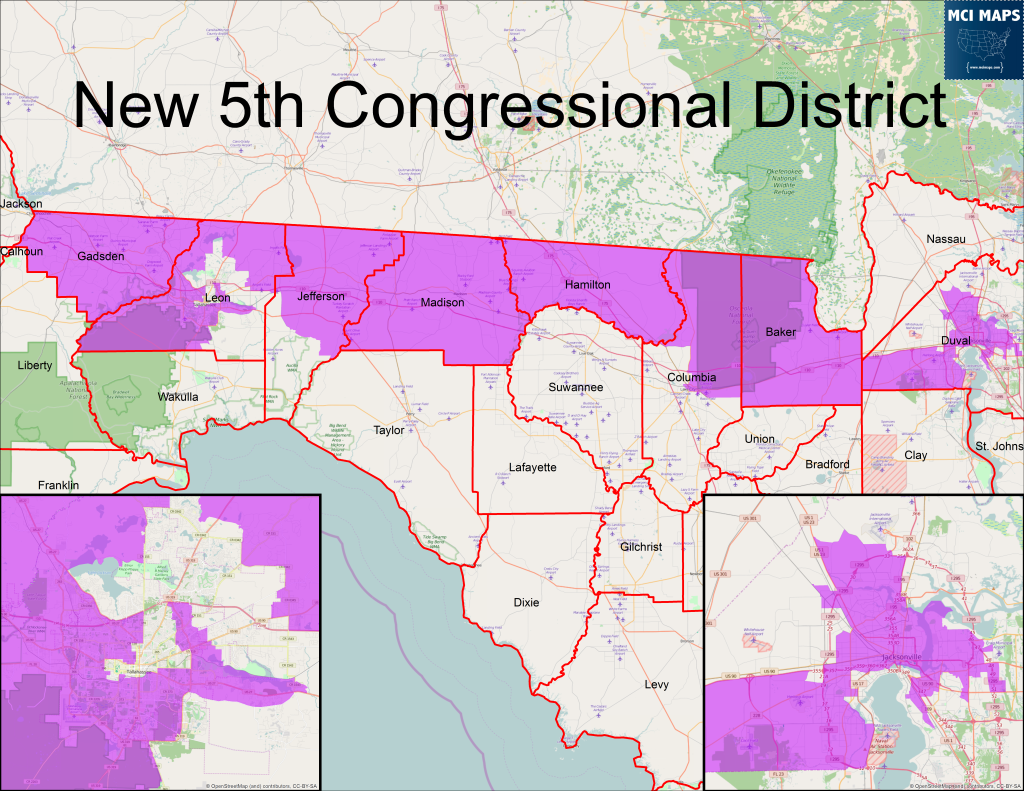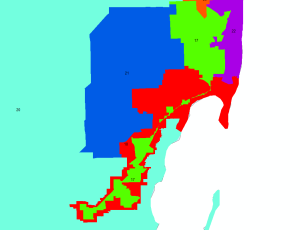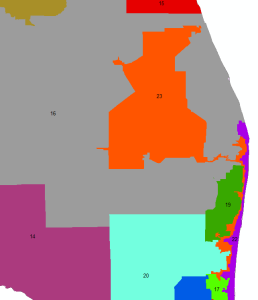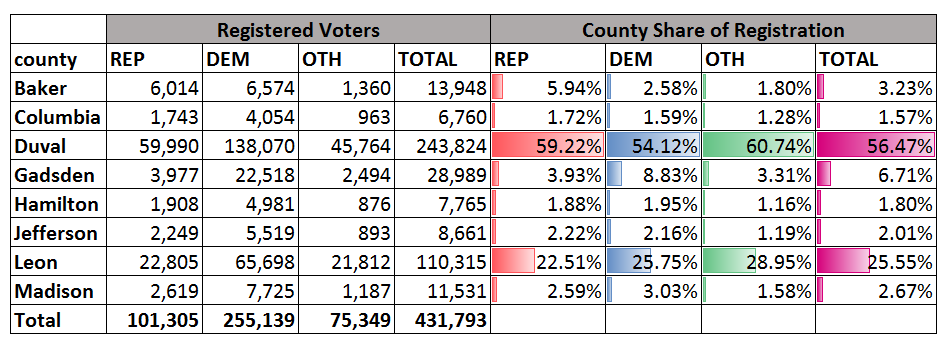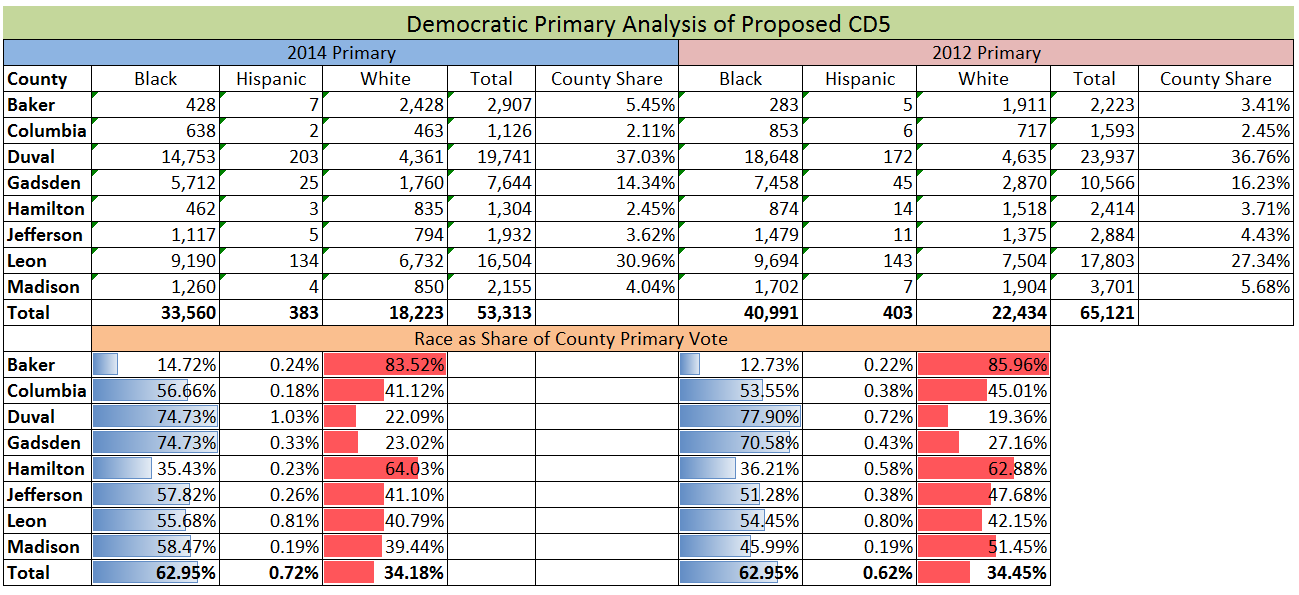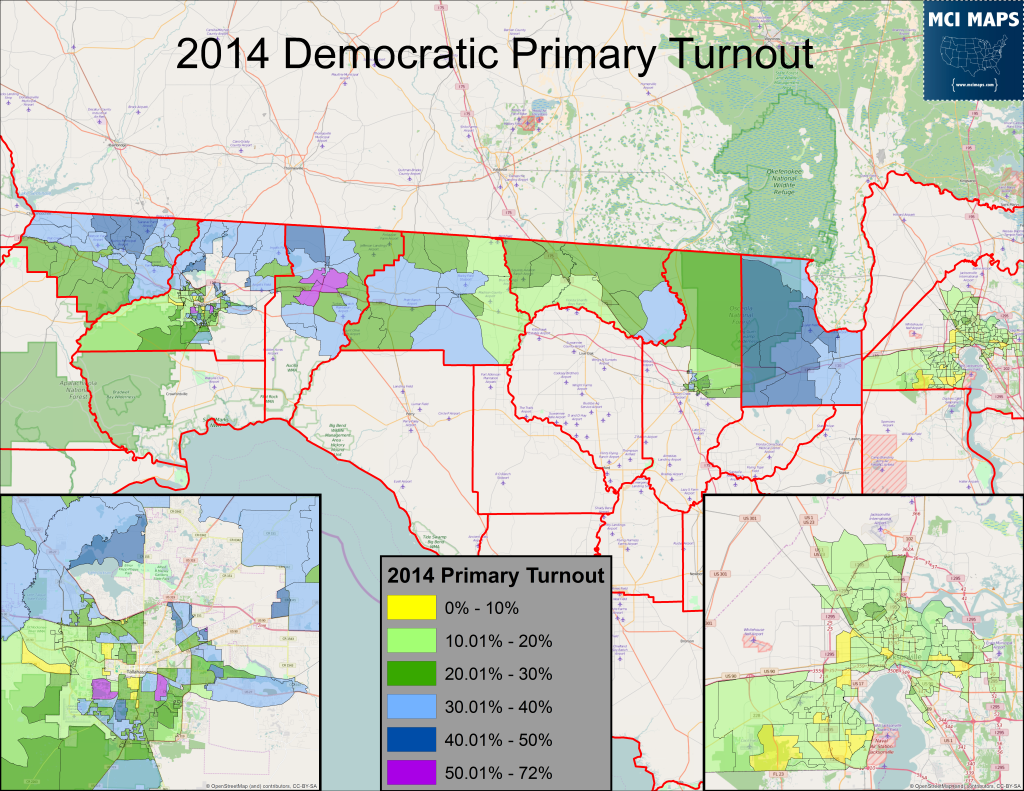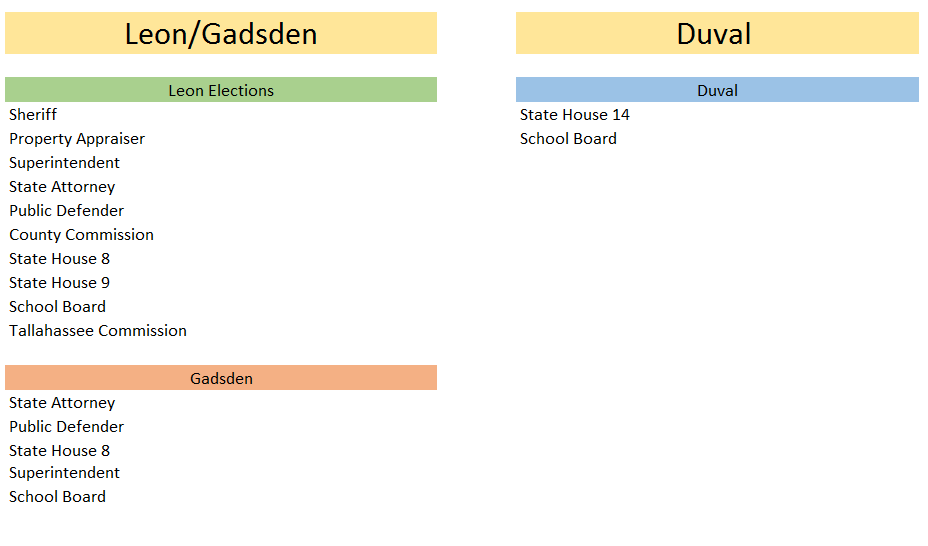Now that Florida’s Supreme Court has signed off on a Congressional map, the voters of Florida can finally know what districts they live in. For voters in North Florida, this means dramatic changes to their current political situation. Many voters west of Walton County will find themselves either in a safe Republican seat that stretches from Bay to Marion, the Florida 2nd; or a safe Democratic seat that goes from Gadsden to Jacksonville, the Florida 5th. The new 5th district is designed to be an African-American district, replacing the Jacksonville to Orlando configuration of the past.
The plan links African-American voters across North Florida, splitting less counties than the Jacksonville to Orlando configuration.
This proposal as caught to the ire of Corrine Brown.
Corrine Brown’s Illogical Claims
Corrine Brown, the representative for the old 5th configuration, is threatening to sue over the changes, arguing the new plan is not an African-American, or even a Democratic seat. Brown has long sided with Republicans as they sought to keep her district stretching to Orlando in order to protect Republicans in Central Florida by packing African-American voters. Brown stood against the Fair Districts amendments and has been a major opponent of redistricting reform. She even sued along with Republican Congressmen to keep the Fair Districts amendments from being implemented. She has claimed the Supreme Court is treating black voters like chattel. This inflammatory language has no place in public discourse, especially when its backed by zero facts. Brown claims several things when arguing her district must not be changed, none of which hold up to scrutiny.
- She claims the district is not a Democratic seat: However, the district gave Barack Obama 63% of the vote and Charlie Crist 59%
- She claims the district is not African-American: Fact is African-Americans are 63% of the Democratic primary, which picks winners
- She claims her district was drawn by a federal court: In fact the original district was struck down by SCOTUS and many later changes were made
The fact is, Brown has always been against even the most modest changes to her district, claiming the African-American percentage must remain the same, ignoring that even a lowered black population would make the district more compact and retain the district’s African-American dominance. Additionally, the creation of the East-West configuration has allowed for a congressional seat in Orange that is over 50% black in the Democratic primary and heavily Democratic in the general. This district is one that Brown is now considering running in. Keep that in mind; Brown is debating running in a new African-American seat, one that has a lower African-American share than the new 5th district, which she claims isn’t African-American at all. These inconsistencies are nothing new with Brown.
Brown’s claims about the origin of her district go back to the 1990s. This article will offer a quick backstory.
The History of the District
Brown’s congressional district was initially drawn by a three judge panel after the Florida legislature could not agree on Congressional redistricting. As Florida’s demographics continued to shift, different ethnic and partisan alliances were formed to draft lines or proposals. The three judge panel was initially tasked with picking a plan from several proposals. You can click a map for a higher resolution version.
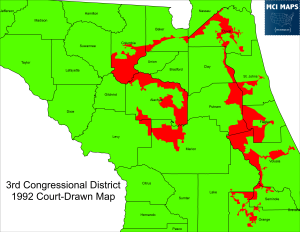

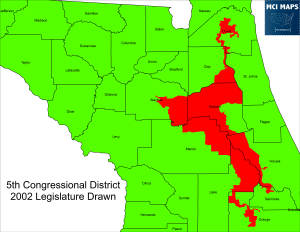
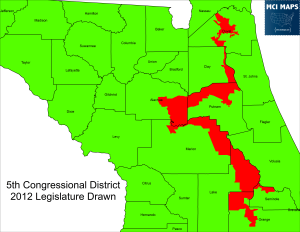
So as we can see, the district has undergone many changes in the last two decades. Brown claims her district was drawn by a court, but that ignores all the changes that have occurred. It also ignores the shifting demographics of the state; which means other considerations could be used with each apportionment. In 1994, only 10% of Orange County registered voters were black, a figure that now stands at 17.6%. In addition, Orange County became so large it can now house Congressional seats within its border. Populations change and new considerations are needed. In addition, she cites the three judge panel that created her district. However, I invite you to look at other parts of that map. The plan is filled with districts that have crazy appendages and weird loops. Not the standard of good districts.
Brown may not like it, but this new district is here to stay, at least until 2022. The question now is, how will that election shape up?
The Upcoming Primary for the Florida 5th
Rumors are continuing to swirl about the upcoming primary for Florida’s 5th district. Corrine Brown has leaked that if the maps are upheld in federal court (they will be) then she is likely to run in the Orange County-based 10th district. If Brown moves, other Jacksonville politicians are eyeing the seat. State Representative Mia Jones, former State Representative Tony Hill, and current State Senator Audrey Gibson have all indicated interest but are waiting for Brown to make her plans known. However, the western politicians are not going to defer to Brown, who has little allegiances in the west. Tallahassee Mayor Andrew Gillum is considering a run for the seat and former State Senator Al Lawson has announced he intends to file in January. Notice that all candidates mentioned are African-American. It is unclear if a white candidate will make a play for the seat.
Looking at the registration breakdown in the district, Duval County (Jacksonville) dominates. 54% of registered Democrats come from Duval compared to the 26% from Leon (Tallahassee) and 9% from Gadsden. Gadsden County, the state’s only majority African-American county, is to the west of Leon.
Leon and Gadsden are politically close, sharing state Senate and state Representative districts; as well as both being part of the 2nd judicial circuit. Many who work in state and local government in Tallahassee live in Gadsden. Gillum or Lawson would rely on a united Gadsden and Leon to have a shot at winning the seat. Jefferson and Madison are also more closely aligned to Tallahassee than Jacksonville, but by a lesser degree. Columbia, Hamilton, and Baker have little ties to either region.
Even when Leon, Gadsden, Jefferson and Madison are united, they are still swamped by Duval. This can give the impression that Duval will dominate the primary. However, the turnout dynamics actually shift favor to the West. Jacksonville’s low turnout causes its share of the vote to be dramatically reduced, allowing the other counties, especially Gadsden, to see their share increase. The chart below shows each county’s share of registration and their share of the last two primaries.
In both 2012 and 2014 Duval’s, primary share was 36-37%, while Leon hovered between 27% and 31%. Gadsden boasts higher turnout in Presidential primaries, when many of its local offices are on the ballot, and its share increases as a result in Presidential years. The difference in Leon’s share is not that it cast fewer votes in 2012, but rather that other counties simply cast much more in 2012 than they do in 2014. Leon’s turnout always remains strong thanks to its large state employee population, allowing its influence to be greater in the midterm cycle when turnout is lower (same for the general election in midterms).
A more detailed breakdown of the 2012 and 2014 primaries is here, with the racial makeup of the counties also broken down.
Leon sees little raw vote falloff between 2012 and 2014, hence its increased share in midterms. However, Leon and Gadsden both equal 43-44% in both primaries compared to Duval’s 37%. In a 1 on 1 race between a West and East candidate, the eastern politician would need to either get some votes in Leon/Gadsden or make inroads into the other counties. In Leon, both Lawson and Gillum would likely do very well with the white population that makes up 40% of Leon’s vote. Both candidates have done very well with white and black voters in their many elections. Gillum has scared off serious competition for every election since he initially won office in 2003. He faced token opposition in his mayoral election in 2014 and is a rising star in the state. Lawson, meanwhile, is an institution in the west, serving as a lawmaker since the 1980s and running for Congress in 2010 and 2012. In his 2012 campaign, he won over 70% of the primary vote in Gadsden and the portion of Leon in the 5th in a four-way race. When Lawson challenged incumbent Congressman Alan Boyd in 2010, Lawson narrowly lost, but beat Boyd in Gadsden and Leon. Either candidate can dominate the West.
Baker is the odd-man out in the district by a large margin. The county used to be over 80% Democratic, but is quickly moving GOP in registration, which will result in its influence being reduced further and further in the primaries. The county’s Democrats are white conservatives and it is easy to see any white candidate winning the votes of the county. In fact, in the 2014 Attorney General Primary, Perry Thurston, the African-American House Democratic Leader, came in third behind George Sheldon and the undervote (people who left the ballot blank).
For this reason, I argued Baker should be minimized in the district, in favor of adding the rest of Leon. However, Baker remains whole in the district.
So why is Duval’s turnout so low in primaries? There are likely many reasons. Larger urban areas often have lower turnout and much of Duval in the 5th is urban/poorer areas. Contrast this with Leon, which has a high number of state employees and school workers. Leon’s dynamic in hosting the state capital means a more engaged voting population, yielding higher turnout in the primaries and general. Leon often has the highest urban county turnout in the state.
Leon’s turnout is far from uniform. The precinct turnout map below shows some areas hosting higher turnout than others. There are some African-American precincts with much higher turnout, and white regions with lower turnout. Overall, the white turnout is higher than the African-American turnout, and with 40% of the vote being white, this further bumps Leon up.
While Leon and the West show diversity in their precincts on the issue of turnout, Duval’s side is much more evened out on the low end of the scale. Turnout only passed 20% in a handful of precincts, going lower than 10% in others. In addition to the dynamics described above, another likely reason for Duval’s lower turnout is its ballot activity. Even in Presidential years, Duval’s primary ballot can be a fairly quiet affair. Most of Duval’s local elections are decided in the spring, leaving only a few races to boost interest. In primaries, already low turnout affairs, the presence of contentious and hard fought local campaigns can in fact drive turnout to increase by a few percentage points. Leon and Gadsden have seen their primary turnout increase or decrease with how contentious the ballot has been. Due to Duval hosting many local races in the spring, their August ballot is often light, while Leon or Gadsden are filled with races. Below is a list of races where Democrats will be able to cast ballots on the upcoming August ballot based on filings as of this week. More races may pop up as candidates get additional challengers, so this is not complete.
The western counties are filled with races for county commission, state attorney, constitutional officers, city commissioners, and so on. Duval right now only has school board races and one State House primary. Leon is actually on schedule to have one of the most cluttered and contentious primary seasons in history, as several long-time elected officials are retiring. As things stand right now, there will be many more races in the west attracting attention of voters for the August primaries. And to be clear, these are not low money races. The Leon Sheriff and Superintendent races already stand to spend hundreds of thousands of dollars. These races will increase interest and could boost turnout as the campaigns work to get voters out to the polls.
Now, the ballot-length issue is anecdotal. The contentious Congressional primary and US Senate primary could boost turnout in the east. However, Leon and Gadsden’s generally strong turnout, thanks to the presence of highly informed, highly engaged voters, will still be an issue for the east. One thing is sure, Duval needs to get its turnout up if it wants to control the primary.
Is Corrine Brown Dennis Kucinich?
Let’s say Corrine Brown runs for re-election in the 5th district instead of the 10th. I think there is a good comparison that should give folks who assume Brown will easily win some pause. That is the case of Ohio Congressman Dennis Kucinich.
In the 2012 redistricting session in Ohio, Kucinich’s Cleveland district was paired with fellow Democratic Representative Marcy Kaptur’s Toledo-based seat
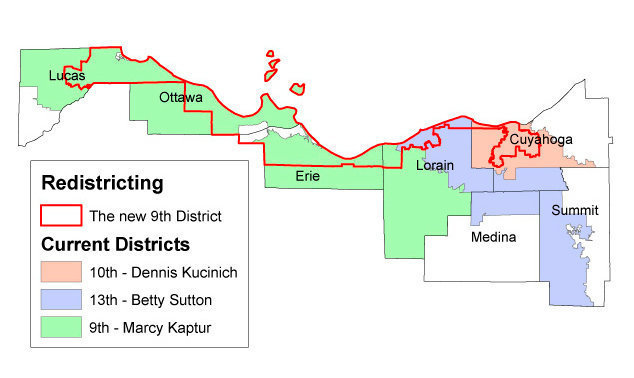
While the new 9th included more land from Kaptur’s seat, the portion of Kucinich’s old 10th constituted over 50% of Democrats in the new 9th district. Kucinich had initially considered running for re-election in a district all the way in the state of Washington when it appeared he might not have a good option in Ohio. However, with the lines giving his city a majority of the Democrats, he opted to run in the 9th. The race between Kucinich and Kaptur got very heated. Both were liberals, but Kucinich had few friends in the establishment of the Democratic Party. The race took on a very significant Toledo (Lucas County) versus Cleveland (Cuyahoga County) dynamic. Kucinich at one point dissed Toledo, claiming its politics were too nasty. This is similar to Corrine Brown claiming that Jacksonville had nothing in common with North Florida, something Lawson hit Brown on back in August.
When the results were final, Kaptur won with 56% to Kucinich’s 40%. Kaptur’s win was due to two key variables. Cuyahoga County, which represented 50% of Democrats in the district, only amounted to 42% of the district’s share of the vote. Second, Kaptur destroyed Kucinich with 94% of the vote in her home base of Lucas, while still getting 24% in Kucinich’s home base.
While Kaptur also won the other counties of the district, it was her margin alone in Lucas that more than made up for her deficit in Cuyahoga.
There are many variables that could have allowed Kucinich to win, but two fairly simply methods would have worked. Had Kucinich dominated in Cuyahoga the same way Kaptur dominated in Lucas, he would have won by just over 800 votes. See below.
Kucinich also could have won if he had made inroads in Lucas County. Had Kucinich managed 30% of the vote in Lucas, while his Cuyahoga margin remained the same, he would have narrowly won. See below.
Kucinich’s biggest problems were weaker turnout in Cuyahoga, reducing its share of the vote, and Kaptur doing better in his home base than he did in hers. Kucinich had the geographic advantage, but still ended up losing. This is similar to Brown’s situation in the Florida 5th. While her base dominates the voter list, its turnout could create problems with the possibility of Lawson or Gillum dominating in the west. Neither Gillum nor Lawson need 90% in the west to win. Also, much like Kucinich’s talk of moving to Washington was used against him when he did opt to run in the Ohio 9th, Brown’s talk of running in Orlando could be used against her if she runs in the Florida 5th.
Conclusions
Regardless of which district Corrine Brown runs in, Florida’s 5th congressional district will host one of the most heated campaigns of the August primaries. If Brown runs, it will be her loyalty and support from the Duval region against western candidates that will use Brown’s redistricting apostasies against her. It is no secret many Democratic groups and left-leaning organizations have little love for Brown over her redistricting stance. However, against Brown, the western counties must be united around one candidate. Both Al Lawson and Andrew Gillum running against Brown will likely ensure Brown’s re-election. However, if Brown runs in Orlando, multiple candidates will likely run in Duval, reducing pressure on the west to be united. A four or five way race could emerge. While candidates will visit all corners of the district, don’t be surprised if a significant regional divide takes place, even in a multi-candidate race. The west stands poised to capture the seat for themselves. However, nothing is certain at this moment.

